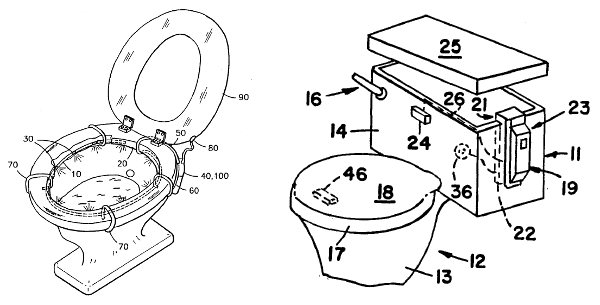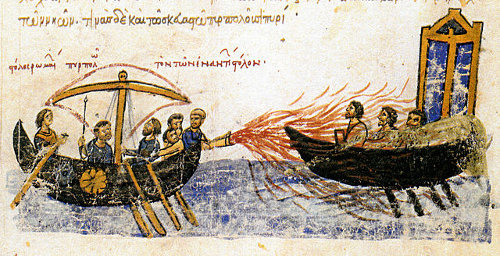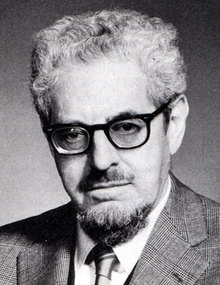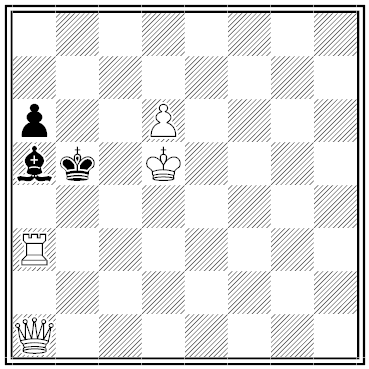Low Tech

Brooke Pattee’s “night light for a toilet,” patented in 1993, mounts a tube filled with electrical lamps under the upper rim of a toilet bowl so that users can use the bathroom without fumbling in the dark or being blinded by the overhead light.
Blake Warrington’s “toilet seat cover position alarm,” patented in 1989, sounds an alarm if the seat cover is not lowered after the toilet is flushed. “The alarm has the practical effect of conditioning persons who use the toilet to routinely close the toilet seat cover.”
Trojan Horse
In 1933 sculptor John Skeaping carved a horse of mahogany and pynkado and sent it to be displayed in Whipsnade Zoo in Bedfordshire. “Perhaps I ought to tell you that I have concealed something in the belly of my horse,” he told the Daily Mail. “It is a little bundle of papers containing my private and personal views and opinions about my contemporary artists and their work! … Posterity (if my horse survives) may get some fun out of what I have written. I hope it will, at any rate!”
Skeaping died in 1980. In 1991, conservation workers at the Tate Gallery found a folded document inside the horse:
This is practically my only opportunity of
Saying exactly what I think about
everyone.
In truth I am only interested in
myself and my own pleasure. I think that almost everyone I know
in the artistic world are just one mass
of stupidity
Henry Moore is a good
sculptor in a very limited way.
Barbara Hepworth has hardly got an
original idea in her head.
There are no other sculptors except
J. Epstein is one of the best artists
that we have
_____ Cedric Morris is one of the
_____ painters
__ and _____ ____ people I am ______.
The missing sections had faded or been eaten by insects. “I found this concealed artefact strangely moving,” wrote poet Paul Farley. “It was as if the art object, built from sound materials and designed to endure, had admitted something very human and very fragile.”
In a Word

scalariform
adj. resembling a ladder
Above the facade of the Church of the Holy Sepulchre in Jerusalem is a ladder that has remained in place since the 19th century. At that time an edict was passed holding that the church’s doors and window ledges are “common ground” for the various Christian orders; as a result, no church can move anything near the window — including the ladder. It’s visible in the engraving below, which was made in 1834.
(Thanks, Randy.)

Victimized
As he enters the room, he knows what awaits him. Resistance is useless. He cannot escape; there are simply too many of them, and there is nowhere to hide anyway. Hands take hold of him and strap him tightly. Now he cannot move. They have total control over him. They set to work quickly, efficiently, and without malice. They follow a strict protocol, their actions being exquisitely coordinated toward a single end. They begin to kill him, deliberately and methodically. This is not their first time to take life. They make no attempt to conceal their intentions or their actions. On the contrary, they do everything in public, before an audience who watch as his life ebbs away.
“If premeditation is central to the handling of homicide, this killing ought to evoke considerable severity. But it does not,” write University of Georgia sociologist Mark Cooney. “In fact, the law tolerates it, and some people even praise it highly. The words ‘homicide’ and ‘killing’ are rarely used to describe it. Instead it goes by another name: ‘capital punishment.'”
(From Cooney’s 2009 book Is Killing Wrong?)
Lost Weapons

Swords in the ancient Middle East were made of a substance called Damascus steel, which was noted for its distinctive wavy pattern and famed for producing light, strong, and flexible blades. No one knows how it was made.
In defending Constantinople against the Muslims, the Byzantine Empire used something called “Greek fire,” an incendiary substance that was flung at the enemy’s ships and that burned all the more fiercely when wet. But precisely what it was, and how it was made, have been forgotten.
(Thanks, Mike.)

Double Dread
Lyssophobia is fear of hydrophobia.
Bon Appétit

- It is now true that Clarence will have a cheese omelette for breakfast tomorrow. [Premise]
- It is impossible that God should at any time believe what is false, or fail to believe anything that is true. [Premise: divine omniscience]
- Therefore, God has always believed that Clarence will have a cheese omelette for breakfast tomorrow. [From 1, 2]
- If God has always believed a certain thing, it is not in anyone’s power to bring it about that God has not always believed that thing. [Premise: the unalterability of the past]
- Therefore, it is not in Clarence’s power to bring it about that God has not always believed that he would have a cheese omelette for breakfast. [From 3, 4]
- It is not possible for it to be true both that God has always believed that Clarence would have a cheese omelette for breakfast, and that he does not in fact have one. [From 2]
- Therefore, it is not in Clarence’s power to refrain from having a cheese omelette for breakfast tomorrow. [From 5, 6]
So Clarence’s eating the omelette tomorrow is not an act of free choice.
From William Hasker, God, Time, and Knowledge, quoted in W. Jay Wood, God, 2011.
Unquote
“A man of genius has been seldom ruined but by himself.” — Samuel Johnson
Out on Top

During an appearance on The Dick Cavett Show in 1971, publisher and organic gardening advocate J.I. Rodale boasted, “I’m in such good health that I fell down a long flight of stairs yesterday and I laughed all the way.” When Cavett’s next guest, New York Post columnist Pete Hamill, joined them on the couch, Rodale made a snoring sound. Hamill told Cavett, “This looks bad.”
“The audience laughed at that. I didn’t, because I knew Rodale was dead,” Cavett wrote later in the New York Times. “To this day, I don’t know how I knew. I thought, ‘Good God, I’m in charge here. What do I do?’ Next thing I knew I was holding his wrist, thinking, I don’t know anything about what a wrist is supposed to feel like.”
Rodale had died of a heart attack. The episode was never aired.

